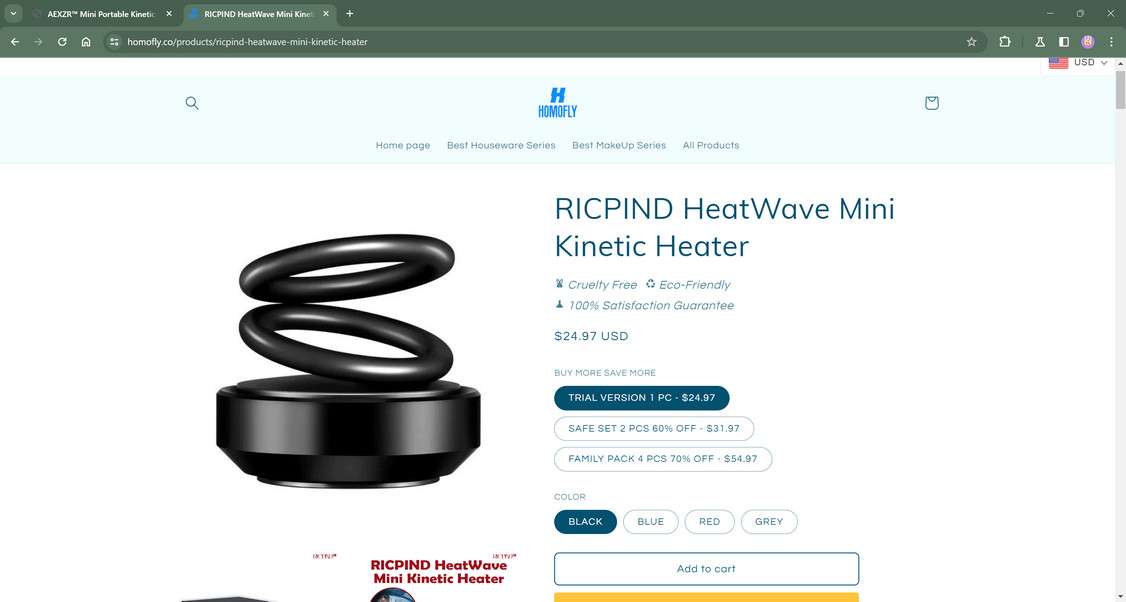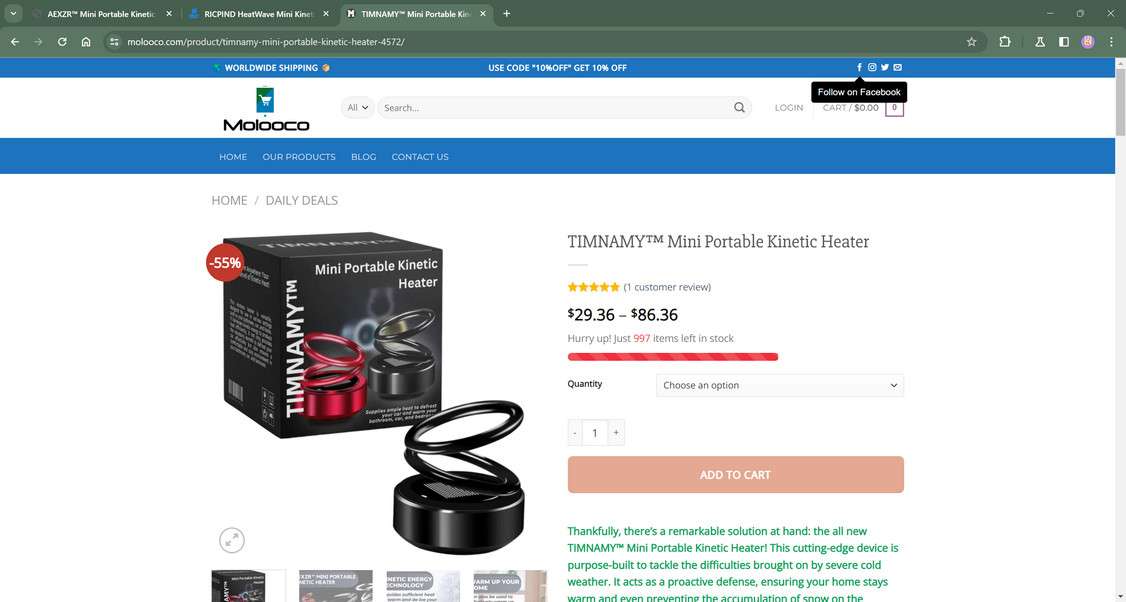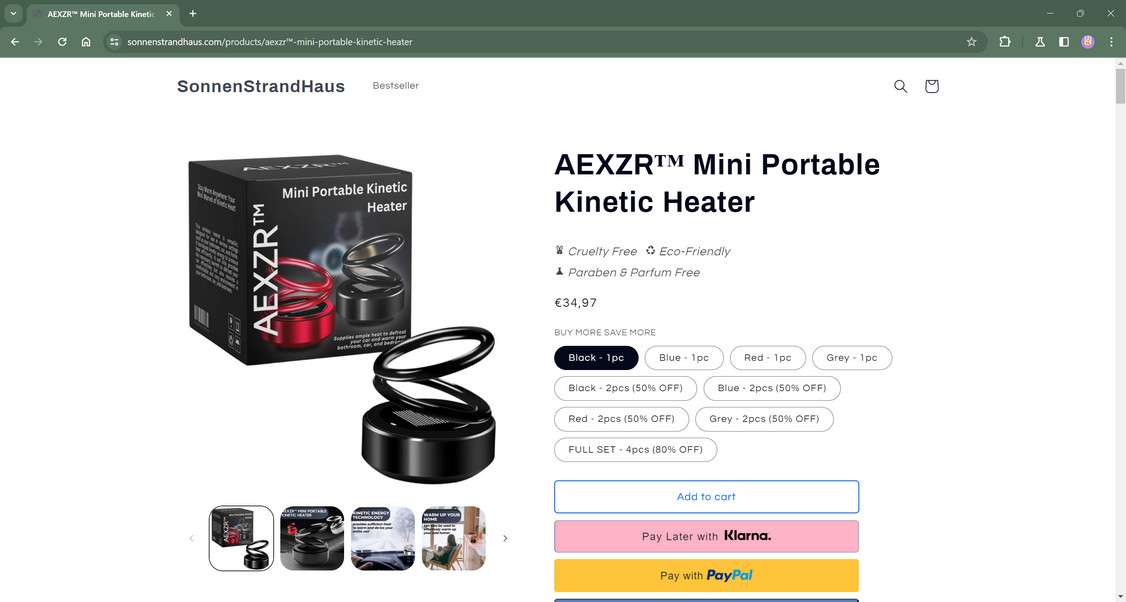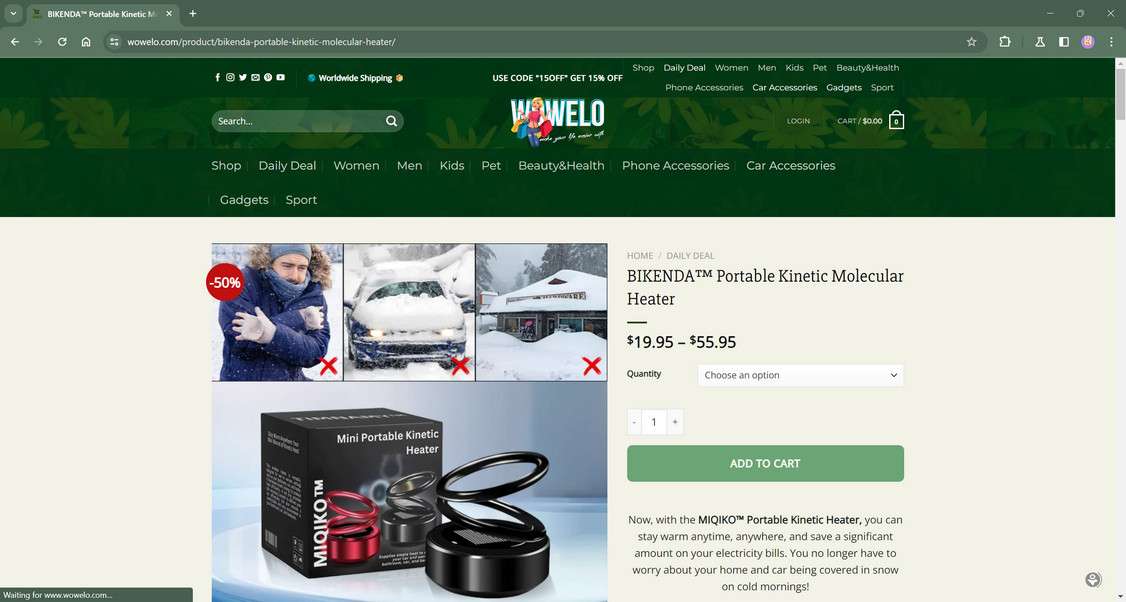A wave of flashy plastic gadgets called “mini kinetic heaters” have exploded in popularity online recently. Heavily marketed on social media and suspicious websites, these compact devices promise to revolutionize home heating and snow removal using so-called “kinetic energy technology”. However, they are actually elaborate scams designed to cheat customers.
This article will delve into how scammers are repackaging $1 air fresheners as mini kinetic heaters, detail the multiple red flags surrounding these viral scams, and provide guidance if you fell victim already. Let’s dig in to keep your hard-earned money safe this winter season.
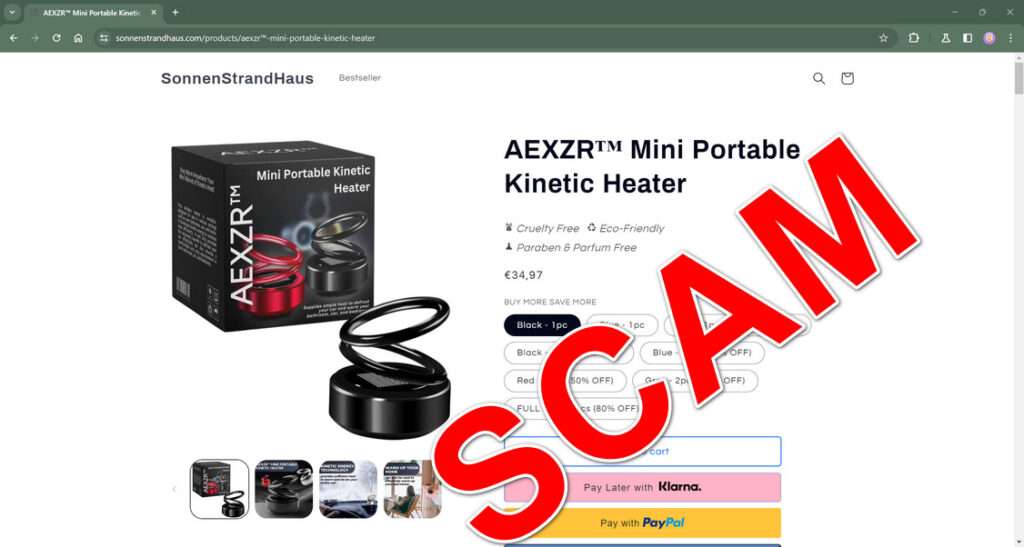
This Article Contains:
An Overview of the Mini Kinetic Heater Scams
In recent months, a wave of products dubbed mini kinetic heaters have exploded in viral popularity online. Highly aggressive advertisements across major social media platforms and networks of suspicious sales websites are marketing these small plastic devices as futuristic, revolutionary new technologies that can effortlessly generate heat, clear away snow, and even power entire homes.
However, upon close examination by diligent consumer advocates, it turns out these heavily marketed mini kinetic heaters are actually elaborate scams designed to deliberately deceive customers.
The deception works like this – scammers acquire very basic $1 car air fresheners readily available on Asian e-commerce sites like Alibaba or AliExpress. They purchase these generic, mass-produced air fresheners in bulk quantities for just pennies apiece.
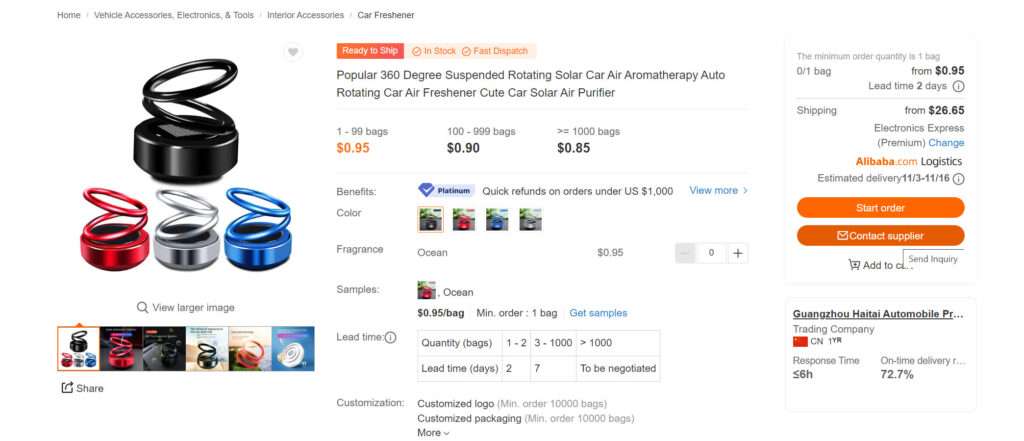
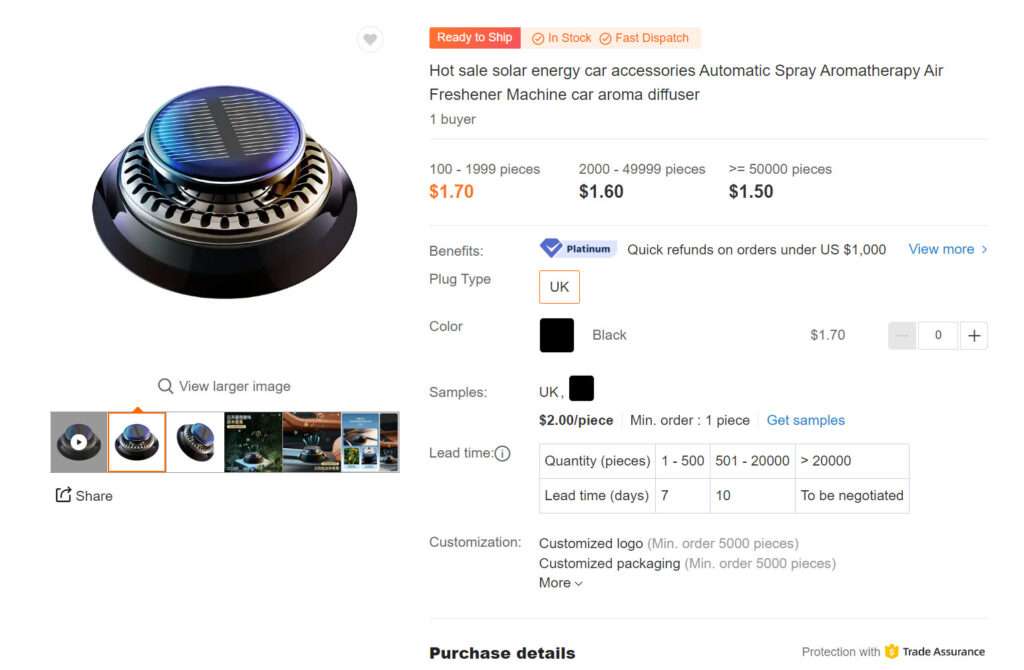
Next, the scammers creatively repackage the cheap $1 air fresheners in newly designed, professional-looking packaging branded as high-tech “Mini Kinetic Heaters” like the AEXZR Portable or FrostGuard Compact. They make it appear that a legitimate company has invented an advanced heating technology.
The scammers then set up numerous flashy sales websites promoting these creatively repackaged $1 air fresheners as scientific marvels that can supposedly generate powerful heating, clear away heavy snow, and prevent ice formation on vehicles using invented terms like “kinetic energy core” or “electron turbine matrix.”
Of course, these wild marketing claims are complete fiction with absolutely no basis or grounding in real science whatsoever. The scammers use exaggerated, pseudo-scientific language, fake 5-star reviews, deceiving videos, and other standard online bait tactics to fool potential customers into buying these cheap, creatively packaged air fresheners for outrageously inflated prices around $39 – $99 each, earning the scammers gigantic profit margins upwards of 5000%.
Here are clear signs the heavily marketed mini kinetic heaters are deliberate scams:
- It’s Merely An Air Freshener: The device itself is identically the same as the $1 air fresheners available on Asian sites, not advanced heating technology.
- Outlandish Marketing Claims: Advertisements boast the air freshener can generate heat and melt snow using kinetic energy. No credible proof supports these exaggerated claims.
- Coordinated Sales Websites: The network of sales pages share extremely similar templates, content, images, and lack of seller details pointing to an obvious scam operation.
- No Proof It Works: There are zero legitimate customer reviews, prototypes, or proof available showing a $1 air freshener could produce heat or clear snow as claimed.
- Refusal of Refunds: The sites strictly prohibit returns and refunds, preventing victims from recovering lost money.
In summary, the heavily marketed mini kinetic heaters are conclusively a deliberate bait-and-switch scam deceiving buyers into paying inflated prices for near-worthless $1 air fresheners falsely portrayed as amazing new heating technology. Consumers should apply extreme caution regarding these devices and their dubious claims.
How the Mini Kinetic Heater Scam Works
The scammers carry out an intricate bait-and-switch deception designed to extract as much money as possible from victims. Here is how the mini kinetic heater scam unfolds:
1. Bait With Social Media Ads
The scam begins with enticing Facebook, Instagram, and YouTube ads boasting these devices use groundbreaking “kinetic energy technology” to heat homes and clear snow with no effort.
2. Funnel to Elaborate Sales Websites
The ads funnel victims to sophisticated sales websites featuring fake “As Seen on CNN” badges and completely fabricated positive reviews to boost credibility.
In reality, the websites share extremely similar templates, stock images, and text pointing to a single scam network operating the sites.
3. Dazzle With Sci-Fi Tech Jargon
The sites baffle potential buyers with pseudoscience terms like “kinetic energy core”, “electron turbine matrix”, and “dual ultra-wave kinetic chambers” to explain how the plastic device supposedly generates heat.
This is complete nonsense technobabble with no basis in real science.
4. High Pressure Sales Tactics
The sites create false urgency with claims of “Limited time only!” and countdown timers pressuring customers to purchase before the fake sale expires.
In reality, these limited-time offers never end. The goal is to rush victims into buying before scrutinizing the outlandish claims.
5. Conceal Seller Identities
No business names, addresses or phone numbers are provided beyond suspicious email addresses.
This lack of verifiable details prevents customers from validating they are dealing with real companies rather than scammers.
6. Aggressively Push Credit Card Payments
The sites strongly encourage credit card payments rather than more secure options like PayPal to make fraudulent charges harder to reverse.
7. Refuse Refunds
The websites prominently display no-refund policies to prevent angry customers from recovering their money when no functional heating product arrives.
8. Send Worthless $1 Air Freshener
Ultimately victims receive either nothing or a cheap $1 air freshener similar to a product found on Alibaba for a few cents.
Even if an air freshener arrives, it’s considered significantly not as described, but refunds are still refused.
9. Rinse and Repeat
The scammers simply repeat the bait-and-switch over and over, collecting as much money as possible from duped victims wanting an easy solution to winter’s challenges.
As you can see, this scam depends entirely on exaggerated marketing, pressure tactics, obscuring product details, and post-purchase obstacles to grossly overcharge for worthless products. If you got tricked already, the next section covers what steps to take.
How to Spot Mini Kinetic Heater Scam Ads on Social Media
Scammers heavily leverage Facebook, Instagram, and TikTok to promote their fraudulent mini kinetic heater bait-and-switch scams. Here are tips for recognizing their deceptive ads on each platform:
Identifying Mini Heater Scam Ads on Facebook
Watch for Facebook ads promoting the plastic gadgets with:
- Headlines like “This futuristic device heats homes with kinetic energy!” or “New invention eliminates icy windshields!”. Outlandish claims are a red flag.
- Videos portraying the device emitting heat waves to warm rooms or melt ice on cars. Effects are usually exaggerated CGI, not real footage.
- Descriptions claiming the gadget uses invented scientific-sounding terms like “kinetic energy core” or “electron turbine matrix”. Made-up technobabble aims to impress.
- Comments disabled on the ads so users can’t point out it’s a scam. Or only positive comments from fake accounts.
- Links to sketchy websites full of dubious claims and stock models/images, instead of reputable retailers. Site domains are often registered in 2022 or 2023.
- Prices of $39 – $99 for a device that looks identical to a $1 air freshener. Wildly inflated pricing indicates a likely scam.
Spotting Mini Heater Scam Ads on Instagram
Watch for Instagram ads promoting the plastic gadgets with:
- Captions like “Revolutionary device taps power of kinetic energy!” or “New tech eliminates winter hazards!”. Outlandish claims are a warning sign.
- Short video clips showing the device emitting heat waves to de-ice windshields or warm rooms. Just exaggerated CGI effects.
- Explanations that it uses made-up science like “kinetic energy conversion” or “electron turbine spin technology”. Techno-babble aims to impress.
- Links in bios directing to questionable websites full of dubious claims and no seller information. Site domains are often recently registered.
- Huge price discrepancies between what’s advertised and what the product visibly appears to be. A $100 “miracle heater” that looks like a $1 air freshener indicates a likely ripoff.
Recognizing Mini Heater Scam Ads on TikTok
Watch for TikTok ads promoting the plastic devices with:
- Captions like “Forget space heaters, this kinetic device is the future!” or “New tech instantly melts ice!” Again, wildly exaggerated claims.
- Videos showing someone placing the gadget in a car or room before heat waves emanate out, melting snow or warming the space. Just CGI effects.
- Hashtags including pseudo-scientific terms like #kineticheater, #energycore, #electron turbine to make impressive but meaningless claims about how it works.
- Links in bios/captions directing to questionable websites full of dubious claims, stock models, and no evidence of real products.
- Accounts repeatedly posting similar ads for kinetics devices, indicating coordinated inauthentic scammer behavior.
The more telltale signs of exaggeration, phony science/proof, and sketchy payment links in a social ad for a compact plastic heating device, the higher the likelihood it’s a scam. Scrutinize carefully before purchase and thoroughly validate seller legitimacy first.
Here is a detailed, SEO optimized section on how to identify scam websites promoting mini kinetic heaters:
How to Spot Mini Kinetic Heater Scam Websites
Scammers rely heavily on elaborate scam websites to promote their fake mini kinetic heater products and process payments. Here are tips for recognizing the telltale signs of their deceitful sales pages:
Copycat Website Designs
The scam sites often share extremely similar page layouts, templates, and assets. This indicates mass-produced cookie-cutter sites rather than unique businesses.
Domains Registered Recently
Scam website domains like aexzrtech.com or frostguardstore.com are frequently registered very recently in the past year. This suggests temporary sites created just for the scam.
Addresses Only a P.O. Box
Contact pages may provide an address, but it leads only to a P.O. Box with no verifiable physical company location or premises. This avoids identification.
Missing Business Names
Sites typically lack a genuine business name, company history, leadership profiles, or anything that can pinpoint the real-world sellers behind it. They avoid exposing their identities.
No Seller Contact Info
Beyond an email address like support@kineticheater.com, the sites provide no phone numbers, business licenses, or ways to directly contact the company selling the product.
Too-Good-To-Be-True Claims
Sites make outrageous claims of revolutionary technology, portraying cheap plastic air fresheners as advanced heating devices. These unrealistic claims aim to impress buyers.
Fake Badges and Testimonials
Sites feature trust-building but false badges like “Featured on CNN” or fake 5-star reviews from non-existent buyers praising the product’s performance.
High-Pressure Tactics
Countdown timers, limited quantity claims, and time-limited discounts pressure customers to purchase quickly before the too-good-to-be-true deal supposedly disappears.
The more sketchy details like these that raise eyebrows, the higher the likelihood the mini kinetic heater website is a complete scam operation. Verify legitimacy thoroughly before you provide any personal or payment information.
What To Do If You’re a Victim of a Mini Kinetic Heater Scam
If you ordered a mini kinetic heater device online and now realize it was a bait-and-switch scam, take the following actions right away:
1. Contact Your Credit Card Company
Since most victims pay by credit card, call your card issuer immediately to report the charges as fraudulent due to receiving a significantly different product than described.
Emphasize that a cheap $1 air freshener arrived instead of the advertised mini kinetic heater. Provide any supporting details and request a chargeback.
2. Report Details to Authorities
File a scam report with the Federal Trade Commission at ReportFraud.FTC.gov and the Better Business Bureau at BBB.org/scamtracker.
Provide all the website names, seller details, product photos, and payment confirmation numbers so they can pursue the scammers.
3. Monitor Your Credit Reports
Check your credit reports at AnnualCreditReport.com to verify no fraudulent accounts were opened in your name by scammers who now have your information.
4. Reset Account Passwords
Change passwords on all of your online accounts like email, shopping sites and banking to be safe. Use unique complex passwords and enable two-factor authentication when possible.
5. Beware Repeat Scam Attempts
Scammers often target those already duped with additional fraudulent offers in the future. Be very cautious of unsolicited communications going forward.
6. Warn Your Social Network
Let your friends and family know about this scam to prevent them from falling for it too. Post details in reviews on consumer sites to create greater awareness.
By acting swiftly, you can limit the trouble caused by this egregious bait-and-switch scam. Remember, spreading awareness helps protect others. Don’t let shame keep you silent.
Our Analysis Confirms It’s a $1 Air Freshener Scam
Our team has thoroughly examined purported mini kinetic heaters. They confirm these viral gadgets are deliberate scams selling $1 air fresheners under false pretenses. Here is some analysis:
- “This is clearly just a cheap air freshener you can buy on AliExpress for $1, not advanced heating tech.”
- “The coordinated sales websites, no seller details, and refusal of refunds point to an obvious affiliate scam formula.”
- “Not one real customer validates these fresheners provide anywhere near the claimed heating powers. Absurd claims.”
- “People are essentially paying $39 for a 60 cent AliExpress air freshener. This is next-level price gouging targeting the gullible.”
- “The lack of any patents, prototypes or proof should make it obvious. This is just an air freshener decoratively packaged as a ‘miracle heater.’”
These so-called mini kinetic heaters are an egregious scam deceiving customers into paying wildly inflated prices for near-worthless air fresheners.
Frequently Asked Questions Exposing Mini Kinetic Heater Scams
What are mini kinetic heaters?
Mini kinetic heaters are viral scam products heavily marketed online and on social media. Scammers are taking $1 air fresheners, creatively repackaging them as “mini kinetic heaters”, and selling them online for inflated prices around $40.
How do mini kinetic heaters supposedly work?
The scam ads and websites claim the device harnesses “kinetic energy” through spinning components to generate heat and melt snow. But these are complete lies intended to fool potential buyers. The products are just basic air fresheners.
What proof do the scammers provide these devices work?
Absolutely no legitimate proof is ever provided. There are no real working prototypes, customer reviews, patents, or scientific evidence. The claims rely entirely on exaggerated pseudo-scientific marketing language, fake testimonials, and doctored video demos.
Can mini kinetic heaters really heat rooms or cars as advertised?
No, they cannot. Mini kinetic heaters are simply $1 air fresheners, not functional heaters. They contain no technology capable of generating enough heat to impact rooms, vehicles, or clear snow. Those claims are outright fabrications to scam customers.
What happens if you buy a mini kinetic heater?
You either receive nothing, or a cheap $1 air freshener product different from what was pictured and described. The scam websites never ship the advertised “miracle” heating devices. They pocket your money and send basic air fresheners instead.
Can you get a refund if it turns out to be a scam?
No – the scam websites strictly prohibit returns and refunds to prevent victims from recovering their lost money. Even if you receive a $1 air freshener, it’s considered significantly not as described, but they still refuse refunds.
Where are these fake mini kinetic heaters sold?
The air freshener scam devices are sold on websites under various names like AEXZR, FrostGuard, Oveallgo, TIMNAMY, HyperHeat, KinetiTemp, and other variants typically containing “Kinetic Heater”.
How can I avoid this scam?
Be very cautious of online ads for any compact plastic heating device claiming to utilize kinetic energy. Research seller details thoroughly and avoid free trial offers. Only use credit cards for added fraud protection. And never trust amazing claims without rock solid independent proof.
Where can I report this scam?
Report it immediately to the FTC at ReportFraud.FTC.gov and BBB at BBB.org/ScamTracker. Provide all details on the product, seller, and website. The more reports there are, the better chance of getting scam websites shut down and preventing additional victims.
The Bottom Line on Mini Kinetic Heater Scams
Given the sheer amount of exaggeration versus credible proof, purported mini kinetic heaters conclusively fail to deliver on their grand promises. There is simply no impartial evidence these plastic gadgets contain any groundbreaking heating or snow melting capabilities.
Until fundamental proof and transparency is provided, wise consumers should treat devices like the AEXZR Mini Heater, Oveallgo Kinetic Heater, FrostGuard Compact, and other mini kinetic heaters with extreme caution.
With so many proven winter solutions already available, there’s no reason to gamble on unvalidated gadgets making extraordinary claims totally disproportionate to their cheap air freshener origins.
In the end, clever scams like these illustrate why carefully scrutinizing both products and sellers is so important before providing payment or personal information. Outlandish claims deserve robust proof. By thinking critically, we can recognize empty pledges before they cost us.
This winter, rely on time-tested products and common sense rather than falling for outlandish ads for miracle devices. Don’t let hope defeat rational thinking. Maintain heavy skepticism of mini kinetic heater claims until fundamental evidence surfaces. Your wallet will thank you.

